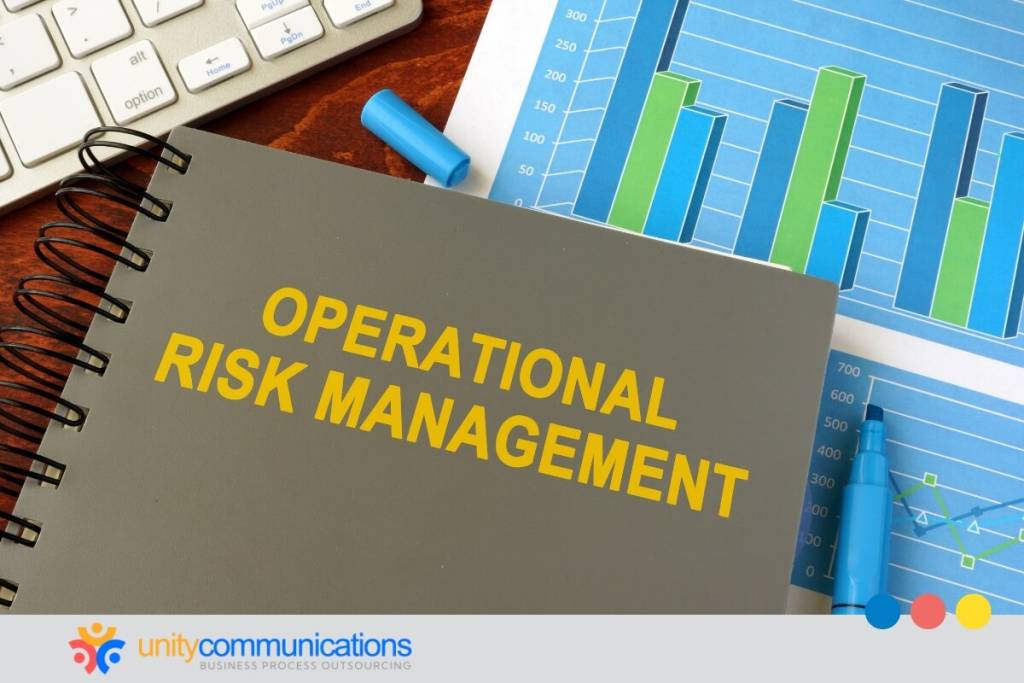Table of Contents
As more organizations rely on business process outsourcing (BPO), understanding operational risks becomes essential for service providers. From data security breaches to operational disruptions, the challenges are multifaceted and demand proactive approaches ranging from compliance to risk management frameworks.
This article delves into the nuances of risk management within BPO settings. Continue reading to learn operational risk assessment and mitigation strategies.
Common operational risks in BPO

BPO companies face various types of operational risks. These risks occur because of the nature of the business model and the types of services provided. To mitigate them, BPO companies must perform operational risk assessments and design robust risk management frameworks.
Here are some common BPO challenges and operational risks:
- Data security and privacy risks. BPO companies often handle sensitive information belonging to their clients. Data and privacy breaches can lead to financial loss, legal liabilities, and reputational damage. A data breach in the BPO sector costs $3.8 million on average.
- Cybersecurity threats. BPO firms handle many client data, making them vulnerable to cyberattacks, such as hacking, malware, phishing, and ransomware. These attacks can disrupt operations, compromise data integrity, and cause financial losses. In fact, 53% of organizations that experienced a data breach incurred financial repercussions.
- Compliance and regulatory risks. BPO companies operate in a highly regulated environment. Non-compliance with industry-specific regulations or data protection laws results in penalties, lawsuits, and business losses.
- Service interruptions. BPO companies rely heavily on technology and infrastructure to deliver services. Any technological disruptions, such as network outages, system failures, or power outages, can affect service delivery in real time, resulting in financial losses and client dissatisfaction.
- Vendor and supplier risks. BPO organizations rely on third-party vendors and suppliers for various services and resources. Risks associated with these vendors include supply-chain disruptions, quality issues, and contractual disputes.
- Employee attrition and talent risks. BPO firms depend on skilled employees to deliver high-quality services. Significant employee turnover rates, talent shortages, and skills gaps can hurt service quality, client relationships, and operational efficiency.
- Geopolitical and location risks. Service providers often operate across multiple geographic locations, including offshore and nearshore destinations. Geopolitical instability, natural disasters, regulatory changes, and economic uncertainties in these locations can threaten business operations and continuity.
- Quality assurance and performance risks. Outsourcing vendors must maintain consistent service quality and performance standards to meet client expectations. Failure to achieve desired service levels, errors, or quality issues can lead to low customer satisfaction, contract terminations, and reputational damage.
- Financial risks. BPO companies face various financial risks, including currency fluctuations, revenue volatility, credit risks, and liquidity constraints. These can affect the bottom line, profitability, cash flow, and overall financial stability.
- Reputational risks. Negative publicity, client complaints, or incidents of misconduct can tarnish a BPO firm’s reputation. Reputational damage results in loss of clients, difficulty attracting new business, and long-term harm to brand equity.
BPO operational risk identification and assessment strategies
What is the BPO industry doing to identify operational risks? Operational risk identification and assessment strategies are in place to effectively manage risks and ensure business continuity. These include:
- Risk identification workshops. Conduct workshops involving key stakeholders and management teams from various departments to brainstorm and identify potential operational risks. Encourage open discussion and collaboration to capture diverse perspectives and insights.
- Risk register. Maintain a centralized risk register to document identified operational risks and relevant details such as their potential impact, likelihood of occurrence, and mitigation strategies. Regularly update the register to reflect changes in the risk landscape.
- Process mapping and analysis. Map out critical business processes within the BPO company to identify bottlenecks and areas prone to errors or disruptions. A comprehensive analysis helps pinpoint operational risks associated with specific processes.
- Root cause analysis. Investigate past incidents, near misses, and operational failures to identify underlying root causes. Analyze patterns and trends to uncover systemic issues and potential risks that require mitigation measures.
- Scenario analysis. Conduct scenario analysis to simulate potential risk events and their impacts on business operations. This action helps you understand the range of possible outcomes and prepare contingency plans to mitigate adverse effects.
- Key risk indicators (KRIs). Define and monitor KRIs relevant to operational risks within the BPO company, such as employee turnover or service-level agreement (SLA) compliance rates. KRIs provide early warning signals of emerging risks, allowing proactive mitigation efforts.
- Internal controls review. Assess the effectiveness of current internal controls to mitigate operational risks. Identify gaps or weaknesses in mechanisms and implement corrective actions to strengthen controls where necessary.
- External risk intelligence. Stay informed about external factors such as regulatory changes, market trends, geopolitical developments, and industry-specific risks that may affect BPO operations. Utilize external risk intelligence sources to assess and anticipate potential risks.
- Vendor risk management. Evaluate the risks associated with third-party vendors, suppliers, and service providers. Conduct due diligence to ensure vendors meet quality, security, and compliance standards. Establish risk-sharing agreements and contingency plans for critical vendors.
Key indicators of operational risks in BPO

KRIs serve as early warning signs of vulnerabilities or issues in various aspects of the BPO company’s operations.
Here are some factors to monitor as part of BPO operational risk assessment:
- SLA deviations. An increase in deviations from SLAs, such as missed deadlines, quality issues, or service disruptions, indicates operational inefficiencies, resource constraints, or process gaps.
- Client complaints and escalations. A rising number of client complaints, escalations, or dissatisfied survey responses suggests underlying problems with customer service delivery, communication breakdowns, or failure to meet client expectations.
- Employee turnover rates. High employee turnover rates, particularly among primary roles or skilled positions, disrupt operations, decrease service quality, and indicate underlying issues with workplace culture, management practices, or job satisfaction.
- Quality metrics fluctuations. Fluctuations in quality metrics, such as error rates, accuracy levels, or customer satisfaction scores, imply variations in performance standards, training deficiencies, or process inconsistencies.
- Technology and infrastructure failures. Increasing technology failures, system downtime, or infrastructure disruptions can disrupt operations and service delivery and reveal weaknesses in information technology (IT) governance, maintenance practices, or disaster recovery capabilities.
- Process bottlenecks and delays. Increasing backlogs or delays in critical processes or workflows can indicate operational inefficiencies, resource constraints, or deficiencies in process design and optimization.
Best practices in designing operational risk management frameworks
Designing an effective operational risk management framework is essential for BPO firms to systematically identify, assess, mitigate, and monitor operational risks. Here are some best practices to consider:
- Risk governance and oversight. Establish clear governance structures with defined roles and responsibilities for overseeing operational risk management activities. These include appointing a risk management committee or officer to supervise the framework’s implementation and effectiveness.
- Risk culture and awareness. Foster a robust risk-aware culture by promoting awareness, accountability, and transparency regarding operational risks. Encourage open communication to empower employees to report risks and concerns without fear of retaliation.
- Risk appetite and tolerance. Define the organization’s risk appetite and tolerance levels, aligning them with strategic objectives, business priorities, and regulatory requirements. Establish thresholds for acceptable levels of risk exposure and ensure that risk-taking decisions are consistent with the defined risk appetite.
- Risk mitigation and controls. Develop comprehensive mitigation strategies and controls to address identified risks effectively. Implement preventive, detective, and corrective controls tailored to specific risk scenarios, considering cost-effectiveness, feasibility, and scalability factors.
- Incident management and reporting. Establish clear protocols and procedures for incident reporting, escalation, and resolution. Implement an incident management system to track and document operational incidents, breaches, or near misses. Facilitate timely response, root cause analysis, and corrective actions.
- Monitoring and reporting. Implement a robust monitoring and reporting framework to track KRIs, control effectiveness, and compliance with risk management policies. Generate regular risk reports and dashboards for senior management and stakeholders, providing insights into emerging risks, trends, and risk mitigation activities.
- Training and awareness programs. Provide ongoing training and awareness programs to educate employees at all levels about operational risks, their roles and responsibilities in managing risk, and best practices for identification and mitigation. Foster a culture of continuous learning to enhance risk management capabilities across the organization.
The bottom line

By implementing BPO operational risk assessment strategies, service providers can enhance their ability to detect and effectively manage operational risks, safeguard business continuity, and enhance stakeholder confidence.
Monitoring KRIs also allows proactive risk identification, enhances operational resilience, and ensures the delivery of high-quality services to clients. Regular assessment of these indicators can inform the organization’s risk mitigation strategies, process improvements, and decision-making processes.
Let’s connect if you want to learn more about outsourcing benefits and ways to mitigate risk.




